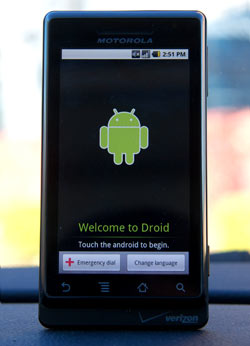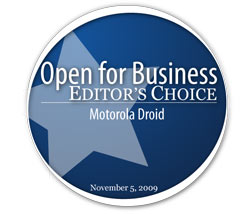
Verizon is on a bold streak. After launching the “There’s a Map for that” campaign squarely targeting what many would call Apple and AT&T’s key weakness – network reliability – the airwaves have now been covered by “iDon’t” ads that compare what the iPhone doesn’t do with what ”Droid does.” So, what does the Droid do and does it do it well? When the device launches tomorrow, do you want to be in line to buy one?
Out of the box, the Droid makes a clear design statement. While most phones coming out at the moment have drunk deeply of Apple’s minimalist aesthetic, the Droid eschews the more organic designs of those devices for an angled, geometric look with two different “levels” visible even when the slider is closed. If you’re looking to make a different statement with your phone, the Droid is happy to help.
 |
|
A friendly Android greets you when you first turn on the Droid. For more pictures of the phone, click here for a gallery. |
There can be little question the phone is well crafted. Amongst phones we have observed here at Open for Business, the Droid is one of the most solid, particularly for a slider. The sliding mechanism is one of the smoothest we’ve tested, traveling along its path easily while also having a very satisfying click at the end of its opening or closing motion.
As to the keyboard itself, at first we found it to be a less than clear “win” for the phone. While having a mechanical keyboard allows a lot more room for information on the beautiful, 3.7” screen, the virtually flat surface of the keys felt a bit odd. Nonetheless, after interacting with it for a week, I found the keyboard comfortable and easy to manipulate for fast typing. Particularly since Motorola has managed to add it without adding much girth to the unit, it feels like an extra input option virtually for free.
The onscreen keyboard used in a portrait orientation also works extremely well, with its attempts at doing type correction being far less intrusive than in most of its competitors. The iPhone’s on screen keyboard is somewhat more effective at type correction, but the Droid’s is remarkably good and eminently usable.
Initial activation of the phone was fast and simple – within just a couple of minutes of being turned on, the phone had already pulled a complete set of contacts onto itself from Google’s Gmail service. The integration with Google services feels very reminiscent to iPhone’s integration with Apple’s MobileMe service, but with a big difference: Google’s services for Android devices are free. Much as an iTunes account is required for iPhone activation, a Google account is required to activate the Droid.
No computer connection is required to get the phone setup, unlike the iPhone. While the Droid does not officially support Mac synchronization, since it primarily syncs “via the cloud,” and current versions of Mac OS X can sync information with Google’s services, this phone ends up being more cross platform friendly than many devices, practically speaking.
 |
With only a few additional taps after the setup completed and Google synced the phone with my Google account contacts, the phone also obliged in merging Facebook data into the contacts, a feature previously trumpeted as one of the unique selling points of the Palm Pre. Additionally, the Facebook merge had the nice touch of offering to sync all contacts or only those with phone numbers. Mark this in the “iDon’t, but Droid does” category.
The touch screen is very pleasant in brightness and color. Thanks to its use of a capacitive touchscreen, it offers sensitivity similar to that of the iPhone, making it a snap (or, rather, a “touch”) to get from function to function. The only significant disappointment is that the capacitive screen and multitouch support in the phone’s Android 2.0 operating system have not brought with them the famed pinch-to-zoom motions in the browser, maps and other apps that make it so easy to manipulate information on the iPhone and Palm Pre. It is not a showstopper, but when the hardware can certainly support it, it seems a shame the feature is not enabled. We can only hope that Verizon adds this support in an update, particularly since the device’s European variant, the Milestone, has pinch-to-zoom.
Our testing found the device’s TI OMAP3 processor provides ample horsepower to keep the interface moving smoothly through clean transitions, program launches and even multitasking. Multitasking is one of the Droid’s main advantages over its designated arch nemesis and with the handy pull down drawer that comes off the top status bar to inform the user of what is going on in various apps, multitasking does work nicely. (Unlike multitasking on the BlackBerry or Symbian platforms, the Droid seems to minimize the sense of running multiple apps and focus on running multiple tasks as one flows from app to app – a subtle difference, but one that is extremely practical in day-to-day use.)
Multitasking can, of course, drain the battery faster, but a thoughtful battery monitor graph reveals which apps have used precisely how much of the battery. With that handy tool, it is rather easy to figure out how to optimize one’s workflow to keep the battery going for as long as possible.
Basic communications functionality is good on the device. Call quality was quite pleasant and the phone almost always managed to pick up a signal, even in rural areas. The Droid appears to have somewhat weaker antenna strength than the Imagio and enV Touch and did occasionally get a very low signal in places that those phones or phones on AT&T’s network did not struggle at, but it is not by any means a poor performer on signal strength. Notably, while the iPhone 3GS had a slight edge on our web browsing speed tests while on Wi-Fi, the Droid dominated when using cellular data. It shined on Verizon's EvDO Rev. A network, often loading pages in less than half the time of the iPhone 3GS on AT&T's 3G network.
 |
|
A crop of a natural light still life from iPhone 3GS (left) versus the Droid. |
The Droid's camera offered somewhat mixed results. The still life crop above shows it struggled in somewhat low, but natural light settings that the iPhone did relatively well in. But the Droid's bright flash helped it to excel in low light situations the iPhone's camera struggles in and it also took vivid shots outdoors (see below).
The overall Android interface seems to be maturing in the year it has been available. The menus are clean and features like the new unified inbox for multiple mail accounts is handy. This simple addition is perhaps one of the most enticing from an iPhone user’s perspective. On the other hand, we were disappointed to see that Google isolates the Gmail account associated with the phone into its own mail application rather than having it mingle with one’s other accounts. It makes a similar distinction between personal and corporate calendars, too.
Overall the Droid’s interface is pleasant, though not as sleek as its stable mate’s, the HTC Imagio, or the iPhone’s. Though certainly less packed with UI “punch,” the phone UI does have smooth transitions and a clean design that is clearly a modern, touch UI rather than an interface with touch added as an afterthought. The entire system is touch-friendly, unlike Windows Mobile, and while the added complexity in Android may make it somewhat less elegant, it certainly is a lot more customizable than the Imagio or iPhone.
The killer app for the Droid is its included navigation software. Joining an exclusive club whose only other member is the Palm Pre, the Droid includes no-extra-cost turn-by-turn GPS navigation software. And, the Droid’s GPS experience sets the bar for navigation design at a new level way above anything else we are aware of. Two features distinguish Google Maps Navigation over other solutions: satellite imagery and Google Street View.
Regarding the first, the Maps app – in which the navigation function is embedded – on Android feels more like a lightweight version of Google Earth – it can provide 3D perspective – than a mere “maps” application. While the iPhone map application can pull in Google’s satellite imagery too, a slight 3D perspective helps give a much better sense of terrain. And, of course, the iPhone’s built-in maps application does not support turn-by-turn directions.
 |
|
Outdoor shots sport vivid, realistic color on the Droid's 5MP camera. |
Navigon MobileNavigator and AT&T’s own GPS solution both bring 3D navigation to the iPhone, but they lack the satellite imagery overlay. This may not sound like a big deal at first, but the “over the head” view of the scenery actually proves surprisingly helpful in spotting landmarks as one is attempting to avoid getting lost. Adding to this aid for avoiding-lossed-ness is the real gem of the navigation tool: the integration with Google Street View. The navigation software can show pictures of upcoming intersections as they really look from the car. This is incredibly helpful in a city or other busy area, since one can go by more than small street name signs when attempting to note where exactly the turn is.
After using the Droid for a week in the lead up to this review, I found it to be a very satisfying experience. While personal preference probably would lead me to rank the Imagio higher in pure “interface experience” (review forthcoming), the Droid is clearly a more flexible phone with a more consistent interface, since only the few including “front facing” apps from HTC sport the interface design that makes the Imagio so nice. On a personal note, as a person who has been an iPhone user since the original was launched, the Droid did more to tempt me towards a different platform than any other phone I have seen.
The Droid is based on a platform with a brighter future, by most indications. Certainly, Verizon’s marketing muscle helps with that – high production value commercials such as “Stealth,” which Verizon has smattered across the networks to promote the Droid’s launch tomorrow, do nothing but help increase public awareness of not just the Droid, but the Android platform, which heretofore has mostly been the talk of the tech elite. As the “iDon’t” commercial acknowledges, the war for smartphone mindshare is primarily one between iPhone OS and Android. The Droid ably represents the Android side, providing some much needed star power.
The rapidly growing Android Marketplace also leaves us optimistic for the ability to expand the phone as time progresses. Apple’s 100,000 app selection of downloadable apps is a formidable advantage for the iPhone, but the Droid allows distribution of apps through not only its own app store, but also through unofficial channels, meaning it will surely build up a large ecosystem of its own, likely with apps that are either directly or practically prohibited by the iTunes App Store-only approach of the iPhone.
Does the phone actually do what the iPhone “don’t”? From a user interface perspective, the Android operating system still does not achieve the same level of intuitiveness that the iPhone has. Nevertheless, features like multitasking, the ability to install applications from a variety of places and a unified inbox are real advantages for the Droid. And, no phone we are aware of has a comparable GPS navigation tool yet. So, yes, the Droid does what other phones “don’t” and that makes it worthy of consideration as your next phone (Motorola/Verizon, $199 with two year commitment; phones.verizonwireless.com/motorola/droid/).
Join the Conversation
Re: What In the World Is That? The Droid Takes Off
Keep in mind though that Verizon just increased the ETF charges to $350 on smartphones. As nice as the phone might be, I’m sure there are plenty out there, including myself, that will have a hard time accepting this fact. Once again, the wall garden that is Verizon does something really cool and criples itself at the same time. Imagine that!
Re: Pagoda's comment
If you’re worried about the ETF fee being raised, don’t buy Verizon. Simple. Leave the phones to people that are going to actually use them. I’m guessing you’re one of those that buy phones, keep them a month and then throw them onto ebay for a profit. Some of up actually buy phones that we’ll use till they’re no longer working. I’m trading my Samsung T619 in on a Droid. Hopefully the ETF prevents idiots like you from ruining my good day and I’ll be able to get one.